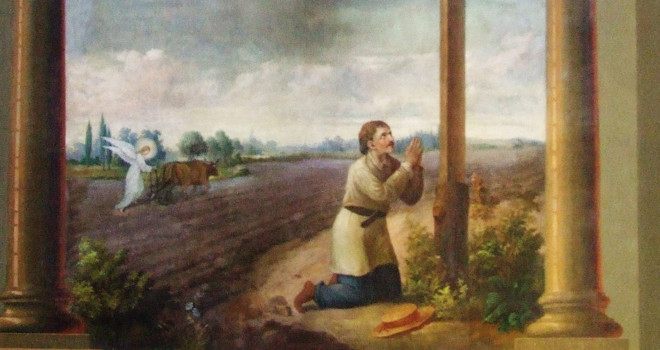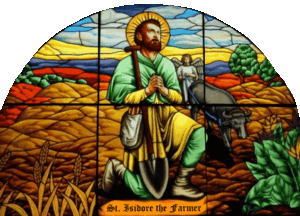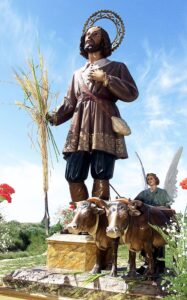
St. Isidore the Farmer was a humble and devout farm worker who experienced many miracles. Isidro (Isidore in English) de Merlo y Quintana was born about the year 1070 in Madrid, Spain. He was named after the great bishop and Doctor of the Church St. Isidore of Seville, and was born to poor but very devout parents. Little is known of his upbringing, except that his parents could not afford an education for their son, but they raised him well in the Faith. Most likely from his youth, he worked as a hired farm laborer on the estate of Juan de Vargas near Madrid. At some unknown date, he married Maria Torribia, and they had a son. One day, the little boy fell into a deep well. At his parent’s prayers, the water level miraculously swelled up so that the child could be easily recovered. So filled with gratitude for this miracle and believing that God was calling them to more active service for His Kingdom, the couple decided to live the remainder of their married lives in continence.
HEAVENLY ASSISTANCE

Isidore devoted himself to his farm work, but devoted himself with great ardor to living a faithful devout life. He attended morning Mass daily. Since this caused him to arrive later for work than the others, they complained to Juan de Vargas that he wasn’t doing his fair share of the work. When de Vargas looked into the situation, it was discovered that an angel was doing the plowing while Isidore was praying or attending Mass. On another occasion, de Vargas witnessed an angel on each side of Isidore while he was plowing, each of them doing his own work, thus tripling what Isidore was able to accomplish. So filled with gratitude at the especially blessed man he employed, de Vargas allowed Isidore to go to town each day to lead the recitation of the Divine Office. He also appointed Isidore to be the overseer of the entire estate. Two known miracles accompanied Isidore for the benefit of his employer: his daughter was brought back to life after dying, and clear, fresh water bubbled up from the dry land when de Vargas experienced a great thirst.
CHARITY AND MIRACLES
Isidore and Maria knew that they were obliged to share what they had with those in greater need. Maria kept a pot of stew cooking each day for the hungry people that Isidore would frequently bring home. One miracle occurred when the pot was empty and more people needed to eat, the pot mysteriously refilled on its own. Isidore also had a great affection for animals, and miraculously saved his donkey from an attack by wolves by his prayer.
When Isidore became seriously ill, he knew his hour was approaching. Instead of resting peacefully and awaiting death, he instead intensified his labors for the needy. He died peacefully on May 15, 1130 at the approximate age of sixty. Several miracles were witnessed at the time of his death. His body was buried in the St. Andrew Church graveyard and was moved into the church forty years later. In the thirteenth century, his body was discovered to be incorrupt. The home of Juan de Vargas still exists, and is a museum which honors the memory of St. Isidore. It has a chapel over the place where Isidore and Maria’s home was and the well where their son was miraculously saved. The saint’s remains have rested since 1769 in the Collegiate Church a.k.a. San Isidro Real in central Madrid.
MIRACLES ABOUND

More than four hundred recorded miracles have occurred from the intercession of St. Isidore the Farmer. Some of these miracles have occurred for Spanish royalty, most notably King Philip III in the seventeenth century, who was cured from being nearly dead when the saint’s remains were brought to him. It was he who introduced the canonization cause for Isidore, who was beatified in 1619, and canonized three years later along with such Church luminaries as Sts. Teresa of Avila, Ignatius Loyola, Francis Xavier and Philip Neri.
For people living in the twenty-first century, it can be easy to forget or disregard the work of people in the field of agriculture. It is important to remember how dependent all mankind is upon such workers and that heroic virtue can be found in people who perform even the most humble forms of labor. St. Isidore lived his uncomplicated life with great holiness. His wife Maria was never formally canonized, but she is lovingly venerated as Santa Maria de la Cabaza. Great feasts honoring this holy couple are held in Spain, the Philippines, Chile, Honduras, Nicaragua and Peru. Madrid and Lima have especially grand festivals on St. Isidore’s feast day of May 15, and that date is often used for the blessing of fields. St. Isidore the Farmer is also known as San Isidro/Ysidro de Labrador, and he is the patron of the city of Madrid, Spain, of farmers, and of dozens of cities around the world.
